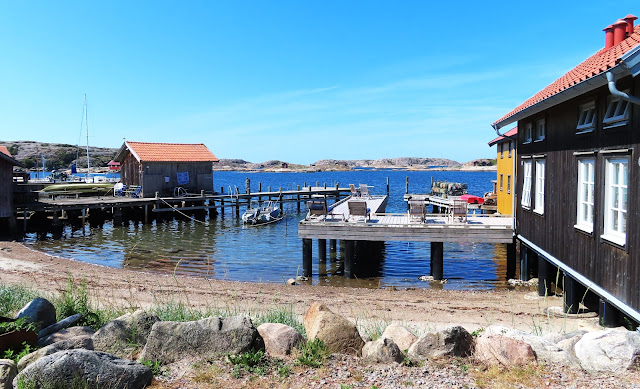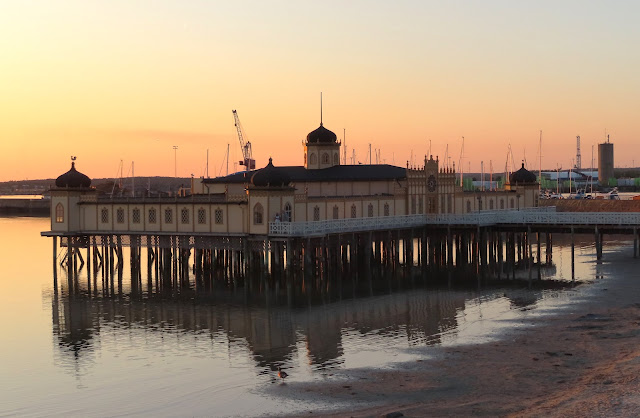June 11: From Denmark back to Sweden
I don’t know if I’ve already said this a million times, but we have been SO lucky with the weather on this trip! Every day has been sunny and WARM. (I should have packed even lighter!) We left Ærø Island bright and early (although there was a bit of a wait for the ferry, as the one that was to have taken us broke down.) We were on our way from Denmark to Norway, but on this day and the next, we would be driving up the west coast of Sweden. At lunch time, we made our last Denmark stop in Helsingør, which we Shakespeare lovers know as Elsinore, home of Hamlet, Prince of Denmark. We had quite a short stop there, so I bolted down my lunch in the giant food court and headed across the field to the moat-ringed castle, which is actually named Kronborg Slotte (Danish for Castle).
The castle was not as impressive as most of the ones we had seen on the trip so far, as it did not display the usual ornate decorations and painted ceilings. But it has a prominent role in Danish history. It's position at the entrance to Øresund, the narrow sound between Denmark and Sweden, and the gateway to the Baltic Sea, allowed it to protect the Sound Dues, or tariffs that had to be paid to travel this route. Its strong walls and moat demonstrate that it was a fortress as well as a royal residence.
In the 1420s, Eric of Pomerania built the first castle, the ”Krogen”, on this unique site. In 1574 King Frederik II began the construction of the Renaissance castle and the surrounding fortifications, which would eventually be known as Kronborg Castle. Following a disastrous fire in1629, the castle was reconstructed almost exactly as it was before. The Chapel, which was the only building not to have been ravaged by the fire, has preserved its original altar, gallery, and pews, with fine carvings and painted panels. (Unfortunately, my short time here did not allow me to visit the chapel.)
Today, it is a UNESCO World Heritage Site and a popular tourist destination, (despite the disappointing news that Hamlet never walked these ramparts.) I wondered why Shakespeare had placed Hamlet here and discovered that Hamlet is based on the Scandinavian legend of Prince Amleth. Shakespeare most likely chose Elsinore because the castle was politically significant at the time. King James I, who ruled England during the latter years of Shakespeare's life, stayed in this castle with his Danish Queen Anne after their marriage in 1590.
 |
| Cannons guard the Kronborg Fortress |
Because of the limited time here, I zipped quickly through the large rooms, which held some impressive antique furniture and large tapestries.
 |
The Banquet Hall was used as an office, a meeting room, a dining room,
and a salon for government meetings and banquets. |
 |
| A 17th century bedroom (photo above) and salon (photo below) |
 |
A "Parade Bed" - Parade Rooms were not private bedrooms. From a Parade Bed,
nobility would receive guests while already sitting and fully dressed. |
 |
| The entire 2nd floor was intended for parties, with guest rooms and banquet halls. When not in use, they were convenient for storage. It was not custom that apartments were ready for use. Instead, they were left empty, and royal visitors brought their own furniture and staff! |
 |
The Kronborg Tapestries
The seven tapestries of kings in the Little Hall belonged to a series of 43 tapestries originally ordered by King Frederick II for the Ballroom at Kronborg in 1591. A total of 100 Danish kings were portrayed on the tapestries, which were made in Elsinor under the management of a master from Antwerp. |
 |
A tapestry depicting the short reign of King Abel (1250 to 1252)
A quiet peasant scene and a group of soldiers in the background sharply contrasts the ferocious acts spelled out in the accompanying verses: "For kingship I did crave. Thus my brother I sent to the grave."
The evil king himself was killed in an uprising only two years after the ruthless assassination of his brother. |
 |
| Kings Erik VII and Erik VIII |
 |
| Of course, you can't have a castle without a Throne Room - even if it is a very simple one. |
My favorite part of the visit was underneath the castle. The long, dark tunnels carved through the rocks used to house the soldiers barracked in the castle, but now it holds an enormous glowering statue of Ogier, the Dane, a famous legendary Viking. The legend says that if Denmark is threatened, he will awaken and save the people. Although Ogier (AKA Holger) didn't show up personally, one of the most famous resistance groups in WWII Denmark was named after him and fought valiantly against the Germans.
 |
| Entrance to the barracks tunnels beneath the castle. |
 |
Imagine all of the feet that walked these steps over the centuries -
enough to wear depressions into the bricks! |
 |
| One tunnel in the maze of tunnels beneath Kronborg Castle |
 |
Ogier the Dane - his legen is told on the sign below.
|
With only minutes to spare before the bus left, I had to dash through the impressive gift shop, which was full of Shakespeare memorabilia. I thought about picking up a copy of Hamlet, but when I checked, it was written in Danish.
We ended the bus ride in the Swedish coastal town of Varberg. The Hotel Gastic was old but had a large pretty lounge with comfortable chairs for sitting and enjoying drinks and conversation.
 |
| The Lounge in Hotel Gastic |
We were on our own for dinner, so several of us had a great dinner at the hotel’s restaurant across the street and then walked through the park to Varberg Fortress, the large fortress that used to guard the town against invaders from the sea.









































































